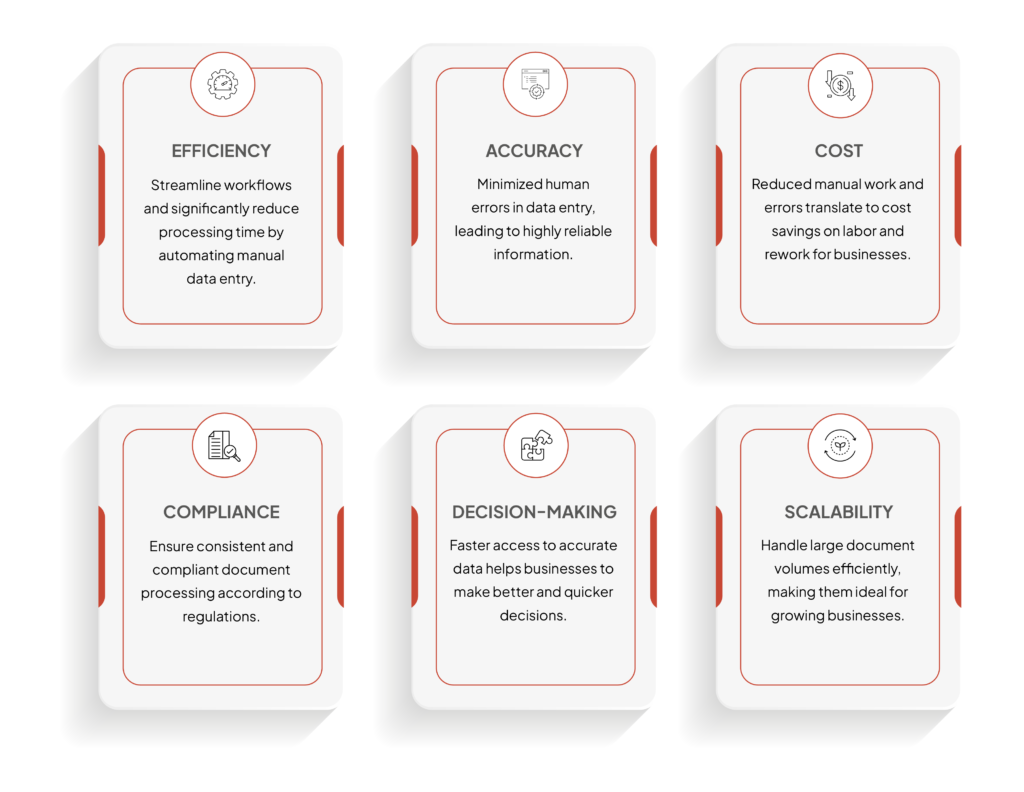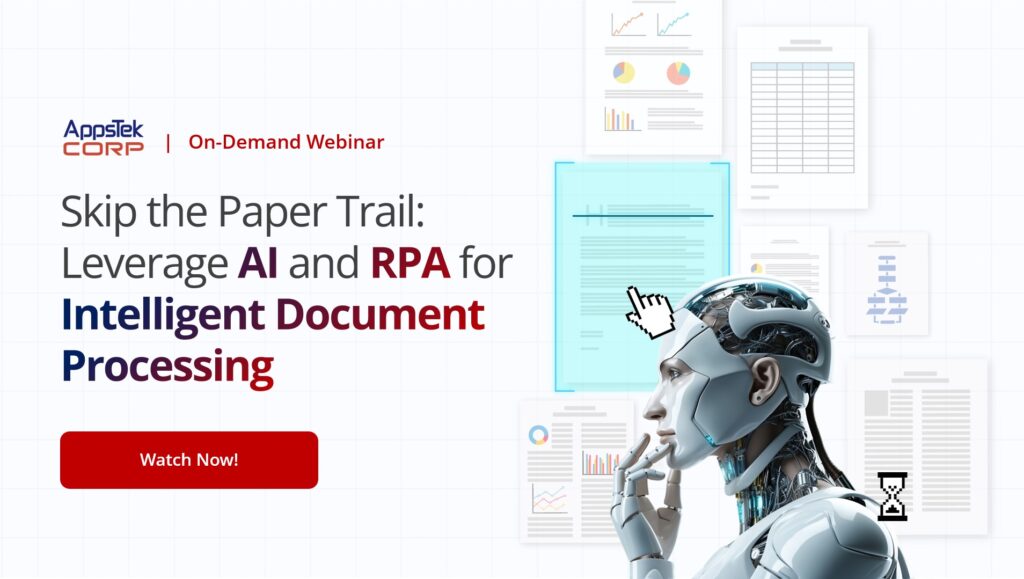Efficient document processing is essential for business success. However, many organizations remain bogged down by manual data entry, errors, and inefficient workflows. These challenges can significantly hamper operational efficiency and hinder business performance. This begs the question: is there a better way? Let’s find out.
The Hidden Costs of Manual Document Processing

Manual document processing is a costly and time-consuming burden for many organizations. With increasing regulatory requirements and complex business operations, the volume and variety of documents have grown significantly. Traditional document management methods are no longer sufficient to meet the demands of modern operations.
- Time-Consuming: Manual document processing is slow and inefficient, requiring multiple steps from sorting to data entry A recent study highlights that 66% of businesses spend over five days per month processing invoices alone.
- Data Errors: Manual data entry is error-prone, with error rates between 18% and 40%. These inaccuracies can result in problems such as incorrect cost calculations, payment delays, and resource wastage.
- Format Issues: Businesses receive documents in various formats (paper, scans, etc.), making processing complex. Unstructured documents can be misinterpreted, causing delays and errors. This can lead to more time spent on conversions, clarifications, and corrections, further slowing the process.
How ADP Has Advanced Document Processing for Better Results

Automated document processing (ADP) utilizes artificial intelligence to streamline the classification and extraction of information from business documents. This technology effectively replaces manual document processing for improved efficiency and accuracy.
- Gain 10X Efficiency: ADP is ten times more efficient, processing documents in just 30-60 seconds. These documents are swiftly routed to the correct departments for same-day approval and can also be integrated into other applications for further automation.
- Eliminates Human Error: Automated systems reduce errors by removing the need for human input. This also makes it easier to meet security compliance standards.
- Improved Security: Manual document processing has security risks, while automated systems use strong data encryption to protect sensitive information.
- Easy Access with Cloud Storage: Manual processing requires multiple physical copies and secure storage of originals. Automated document processing stores information in the cloud, allowing access from anywhere and on any device.
Where Does Automated Document Processing Fall Short?

While automated document processing is a significant step forward for document processing, it’s only a part of the solution. Unstructured data, such as documents, videos, and sensor data, accounts for a massive 80% of all business information. Storing, managing, and protecting this vast amount of data remains a major challenge, even with automation in place.
- Limited Understanding of Context: While automation excels at data extraction and processing, it can struggle with complex documents or those lacking clear structure. Nuances and context within documents might be missed.
- Exception Handling: Automated systems might not be able to handle unexpected situations or exceptions that arise during document processing. Human intervention might still be needed for complex or unusual cases.
- Integration Challenges: Integrating automated document processing with existing business systems can be complex and require customization. There could be compatibility issues or a need for additional development work.
- Vendor Lock-In: Reliance on a specific vendor’s automated document processing solution can lead to limitations and higher costs down the line. Businesses might struggle to switch providers if their needs evolve.
Intelligent Document Processing (IDP) as a Complete Solution

Automated Document Processing (ADP) is a dependable technology for handling well-organized documents. It uses Optical Character Recognition (OCR) to accurately recognize text. However, ADP can struggle with documents that are complex or lack a clear structure.
This is where Intelligent Document Processing (IDP) takes document processing a step further. It utilizes artificial intelligence (AI) and machine learning (ML) to understand the meaning and context within documents, even those that are unstructured. This allows IDP to extract information more accurately, making it a valuable tool for businesses that deal with a wider variety of documents.
Why Should Businesses Use Intelligent Document Processing (IDP)?
According to a study, companies that have embraced IDP solutions to automate their workflows have experienced significant benefits, including a remarkable reduction in processing time and a substantial decrease in labor costs, often reaching up to 30%.

- Extracting Valuable Information: Traditional document formats like paper and PDFs can hold valuable business information. Intelligent document automation utilizes artificial intelligence (AI) and machine learning (ML) to convert unstructured data into a usable, structured format, enabling real-time utilization.
- Consistent Accuracy and Streamlined Workflows: Compared to manual processing, intelligent document automation offers consistent accuracy in document classification and data extraction. Additionally, AI document processing efficiently assigns tasks to the most suitable resource. While document organization and review are crucial business functions, they can be tedious. AI technology allows employees to dedicate their time to more strategic and decision-making activities.
- Improved Invoice Processing and Faster Payments: Implementing AI in invoice processing workflows can accelerate payment cycles and enhance accuracy. Automation of data extraction and validation, along with seamless data integration across various systems (e.g., accounting software), reduces manual data entry errors, minimizes invoice discrepancies, and expedites payment collection.
- Enhanced Customer Experience with AI: AI document processing accelerates business processes, ultimately leading to a faster customer experience. For instance, Leroy Merlin, a major home improvement retailer, leveraged automation to streamline their return, refund, and exchange procedures. This involved using robotic process automation (RPA) for expediting payment refunds and AI-powered document processing for extracting customer details to initiate refunds. These advancements resulted in a 55% increase in refund processing efficiency, a 20% boost in their Net Promoter Score (NPS), and a remarkable 90% customer satisfaction rate for their return process.
Partnering with a trusted provider for IDP as a service can help organizations address the unique challenges, they face in managing document-intensive processes. At AppsTek Corp, we leverage industry-leading IDP solutions, using advanced AI and machine learning algorithms for end-to-end document handling, including document capture, classification, extraction, and validation. Streamline operations, reduce costs, and gain a competitive edge by consulting with our experienced professionals.
Ready to Transform Your Business with Intelligent Document Processing? Watch Our Webinar
Intelligent Document Processing (IDP) transforms document management by using AI, machine learning, and natural language processing (NLP) to automate data extraction, validation, and integration. This technology streamlines document workflows, boosting efficiency, cutting costs, and improving customer service.
Watch the on-demand webinar, ‘Skip the Paper Trail: Harness AI & RPA for Intelligent Document Processing,’ to explore how intelligent technology can significantly enhance operational efficiency. Discover how automation not only handles routine tasks but also empowers your team to focus on high-value, strategic activities, making informed, data-driven decisions. Don’t miss this opportunity to see how Intelligent Document Processing can propel your business forward!
Simplify Document Processing with IDP




